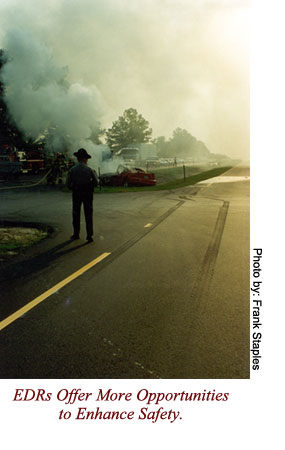Safety Data
Articles,
Products,
Research

Intellectual
Property
EDR
Meetings
Articles
HOMEPAGE
|
Welcome to the NHTSA Event Data Recorder (EDR) Website. EDRs are devices which record information related to an "event." In the context of this site the event is defined as a highway vehicle crash. EDRs can be simple or complex in design, scope, and reach. They have the ability and potential to have a major impact on highway safety, ranging from assisting in real-world data collection to better define the auto safety problem to aiding in law enforcement and understanding the specific aspects of a crash. In 1997, the National Transportation Safety Board (NTSB) issued recommendations to "pursue crash information gathering using EDRs." The National Aeronautics and Space Administration (NASA) Jet Propulsion Laboratory (JPL), in April of the same year recommended that NHTSA "study the feasibility of installing and obtaining crash data for safety analyses from crash recorders on vehicles." In early 1998, the National Highway Traffic Safety Administration's (NHTSA) Office of Research and Development (R&D) launched a new effort to form a working group comprised of industry, academia, and other government organizations. The group's objective were: To facilitate the collection and utilization of collision avoidance and crashworthiness data from on-board EDRs. The Working Group published a report with 29 findings that presented an overview from users to manufacturers. In 2000, NHTSA sponsored a second Working Group looking into EDRs specifically associated with trucks, school buses, and motor coaches based on 1999 safety recommendations by the NTSB. NHTSA has been using EDRs to support its crash investigation program for several years. EDR data are routinely incorporated into NHTSA's crash databases. This Internet Web site is another EDR-related effort to promote the understanding and widespread use of these devices. It is designed to be a useful resource tool for anyone seeking knowledge of the emerging highway-based EDR technologies. By sponsoring this effort, NHTSA encourages dialogue, research and development in emerging EDR technologies towards the goal of fewer crashes, injuries, and deaths. |
 NHTSA does not endorse any products or contributed research cataloged unless authored by NHTSA staff. The information cataloged was accurate at the date of launch but the reader is advised to confirm any facts with the sponsor. |
| If you believe there are errors in this Web site, please contact the EDR webmaster at: EDR.webmaster@nhtsa.dot.gov |
| This website is maintained by the U.S. Department of Transportation, National Highway Traffic Safety Administration, in the interests of information exchange. The opinions and findings expressed in this website are those of the specific contributors and not necessarily those of the Department of Transportation, National Highway Traffic Safety Administration. The United States Government assumes no liability for its content or use thereof. Trade and manufacturers' name and products are mentioned because they are considered essential to the object of the website and should not be construed as an endorsement. The United States Government does not endorse products or manufacturers. |